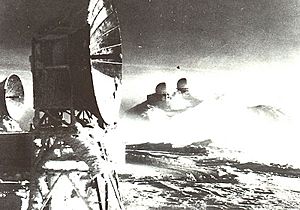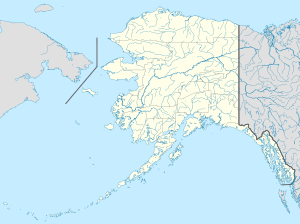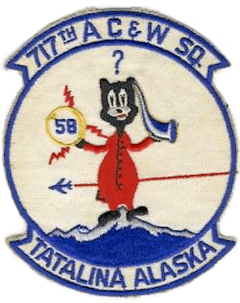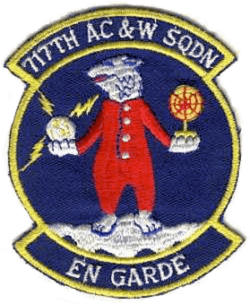Tatalina Air Force Station facts for kids
Quick facts for kids Tatalina Air Force StationTatalina Long Range Radar Site |
|
|---|---|
| Part of Eleventh Air Force (PACAF) | |

Tatalina Air Force Station in winter
|
|
|
Location of Tatalina AFS, Alaska
|
|
| Coordinates | 62°55′44″N 156°00′51″W / 62.92889°N 156.01417°W |
| Type | Air Force Station |
| Site information | |
| Controlled by | |
| Site history | |
| Built | 1952 |
| In use | 1952-Present |
| Garrison information | |
| Garrison | 717th Aircraft Control and Warning Squadron (1952-1983) |
Tatalina Air Force Station (also known as F-10 or A-05) was once a special radar station for the United States Air Force. It is located about 13 kilometers (8 miles) west-southwest of McGrath, Alaska.
This station was originally a "ground control intercept" (GCI) station. This means it helped guide fighter planes to unknown aircraft. It closed on November 1, 1983. After that, it became a Long Range Radar (LRR) site. Today, it is still active as part of the Alaska NORAD Region. This region helps protect the skies over North America. The station is managed by the 611th Air Support Group at Elmendorf AFB in Alaska.
Contents
History of Tatalina Air Force Station
Tatalina Air Force Station was built during the Cold War. Its main job was to give the United States Air Force an early warning. This warning would be if the Soviet Union tried to attack Alaska.
Building the Station
Construction of the station started in 1950 and finished in April 1952. The Army Transportation Corps built it. It was first called Takotna, named after the mountain it sits on. The radar part of the station was on top of the mountain, about 1,067 meters (3,500 feet) high. The support buildings were in a valley at the bottom, about 366 meters (1,200 feet) high.
At first, a road went up the mountain to the radars. Later, a cable tramway was built. This tramway had problems because of strong winds and ice. The cables often broke, and fixing them was dangerous in the extreme cold and fog. Sometimes, ice 40 centimeters (16 inches) thick would build up on the cables.
Army engineers also built a gravel airstrip about 1,158 meters (3,800 feet) long. It was about 3 kilometers (2 miles) southeast of the main base. They also built a road to a river port on the Kuskokwim River. Barges brought all the building supplies and equipment to this port.
Life at the Station
The station had many buildings. These included a power plant, heating plant, and fuel tanks. There was also a gym and other offices. Two other buildings had living areas, workspaces, and fun activities. People could play sports like skiing, skating, horseshoes, and basketball. Most buildings were connected by heated hallways. This meant people could wear lighter clothes indoors, even in winter. The covers of the three radar towers were heated. This kept them from becoming brittle in the extreme cold. Soldiers usually stayed at the station for only one year. This was because of the tough conditions and mental strain.
The 717th Aircraft Control and Warning Squadron (AC&W Sq) ran the radars. These included the AN/FPS-3, AN/FPS-20, and AN/FPS-6 radars. The top part of the station was like a small base itself. Twelve airmen lived there. Two worked on radio maintenance, nine on radar maintenance, and one was a cook. Their living quarters were connected between the radar domes. There were also rooms for relaxing, a library, kitchen, and a movie theater.
How the Radar Worked
Tatalina AFS was a Ground Control Intercept (GCI) and warning station. As a GCI station, its job was to guide fighter planes. These planes were from Ladd AFB. They would intercept any unknown aircraft seen on the radar. In March 1953, the main control center at Murphy Dome AFS near Fairbanks took over. They analyzed the radar data from Tatalina. This helped them figure out how far away, what direction, how high, and how fast aircraft were moving. They also decided if the aircraft were friendly or not.
Communication Systems
At first, the station used a high-frequency radio system for communication. But this system was not very reliable. Weather could easily disrupt it. So, the Alaskan Air Command decided to build the White Alice Communications System. This was a network of special radio sites. The Tatalina site for White Alice was activated in 1957.
The White Alice system was closed in 1979. It was replaced by a satellite dish. This change was part of a plan by the Air Force. They wanted to switch from the old White Alice system to a commercial company for communications.
Upgrades and Changes
Over the years, the radar equipment at Tatalina was updated. This made the information gathered by the radars better and more accurate. In 1983, Tatalina received a new radar called the AN/FPS-117. This radar could work mostly by itself. It sent aircraft tracking data by satellite. This data went to the Alaskan NORAD Regional Operations Control Center (ROCC) at Elmendorf AFB.
Because of this new radar, the 717th AC&W Sq was no longer needed. It was closed on November 1, 1983. The station was then renamed a Long Range Radar (LRR) Site. Only civilian contractors were left to maintain the radar. In 1990, the Tatalina LRR Site became part of the Pacific Air Forces (PACAF)'s Eleventh Air Force.
Cleaning Up the Site
In 1998, PACAF started "Operation Clean Sweep." This project aimed to clean up old Cold War stations in Alaska. The goal was to restore the land to how it was before. After many years of being closed, the buildings at Tatalina had lost their value. The 611th Civil Engineering Squadron at Elmendorf AFB carried out the cleanup. The work was finished by 2005.
Current Status of Tatalina
Today, not much is left of the old Tatalina Air Force Station. The site is managed by the PACAF 611th Air Support Group from Elmendorf AFB. Contractors visit the site using the Tatalina LRRS Airport to maintain the FPS-117 radar. The site is usually empty, with only a few civilian contractors visiting for maintenance.
Air Force Units and Assignments
Units Stationed Here
- 717th Aircraft Control and Warning Squadron
- Started on December 8, 1952
- Closed on November 1, 1983
Assignments (Who They Reported To)
- 531st Aircraft Control and Warning Group, December 8, 1952
- 10th Air Division, April 13, 1953
- 5060th Aircraft Control and Warning Group, November 1, 1957
- 11th Air Division, July 1, 1959
- 5070th Air Defense Wing, August 1, 1960
- Alaskan Air Command, November 1, 1961
- 531st Aircraft Control and Warning Group (later 11th Tactical Control Group, 11th Tactical Control Wing, 11th Air Control Wing, 611th Air Operations Group, 611th Air and Space Operations Center) July 15, 1977







